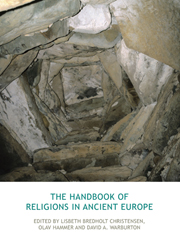Book contents
- Frontmatter
- Contents
- A note on Greek and Latin sources
- Abbreviations and short titles
- 1 Introduction
- PART I PREHISTORIC RELIGIONS
- PART II ANCIENT EUROPE IN THE HISTORICAL PERIOD
- 12 Minoan and Mycenaean religion
- 13 Etruscan religion
- 14 The religions of the Iberian Peninsula
- 15 Italic religion
- 16 Roman religion
- 17 Ancient Greek religion
- 18 The Graeco-Roman cult of Isis
- 19 The cult of Mithras
- 20 Religious Platonism: philosophy and religion in the Platonic tradition
- 21 Insular Celtic religion
- 22 Continental Germanic religion
- 23 Pre-Christian Anglo-Saxon religion
- 24 Old Norse religion
- 25 Slavic religion
- 26 Baltic religion
- 27 Religion in prehistoric Finland
- 28 Sami religion
- Timeline of key dates
- Contributors
- References
- Index
18 - The Graeco-Roman cult of Isis
from PART II - ANCIENT EUROPE IN THE HISTORICAL PERIOD
- Frontmatter
- Contents
- A note on Greek and Latin sources
- Abbreviations and short titles
- 1 Introduction
- PART I PREHISTORIC RELIGIONS
- PART II ANCIENT EUROPE IN THE HISTORICAL PERIOD
- 12 Minoan and Mycenaean religion
- 13 Etruscan religion
- 14 The religions of the Iberian Peninsula
- 15 Italic religion
- 16 Roman religion
- 17 Ancient Greek religion
- 18 The Graeco-Roman cult of Isis
- 19 The cult of Mithras
- 20 Religious Platonism: philosophy and religion in the Platonic tradition
- 21 Insular Celtic religion
- 22 Continental Germanic religion
- 23 Pre-Christian Anglo-Saxon religion
- 24 Old Norse religion
- 25 Slavic religion
- 26 Baltic religion
- 27 Religion in prehistoric Finland
- 28 Sami religion
- Timeline of key dates
- Contributors
- References
- Index
Summary
One of the best-documented non-indigenous cults making its way into pre-Christian Europe was the cult of Isis, whose existence in Egypt can be documented from around the middle of the third millennium BCE. In ancient Egypt she was closely connected to kingship, being considered the sister and wife of the divine ancestor and king Osiris and mother of Horus (the divine identity of Pharaoh) and the foundation of the throne, but over the millennia she also came to appropriate several other functions. Among other things, she was a great magician and healer, a protector of the dead and the living, the mistress of the sky, mother of the gods, goddess of life and rebirth, responsible for the inundation of the Nile. This goddess became gradually more important during the Middle and New Kingdoms (ca. 2000–1600 and ca. 1500–1100 BCE), and by the Late Period (mid-first millennium BCE), she had assumed the status of one of the main divinities of the Egyptian pantheon. In Ptolemaic Egypt – itself influenced by the Graeco-Roman world – she continued to acquire new roles while maintaining two of her most important ancient Egyptian functions (as a magician and the mother and protector of the royal throne) with equal, and perhaps even greater strength than before.
- Type
- Chapter
- Information
- The Handbook of Religions in Ancient Europe , pp. 228 - 241Publisher: Acumen PublishingPrint publication year: 2013



